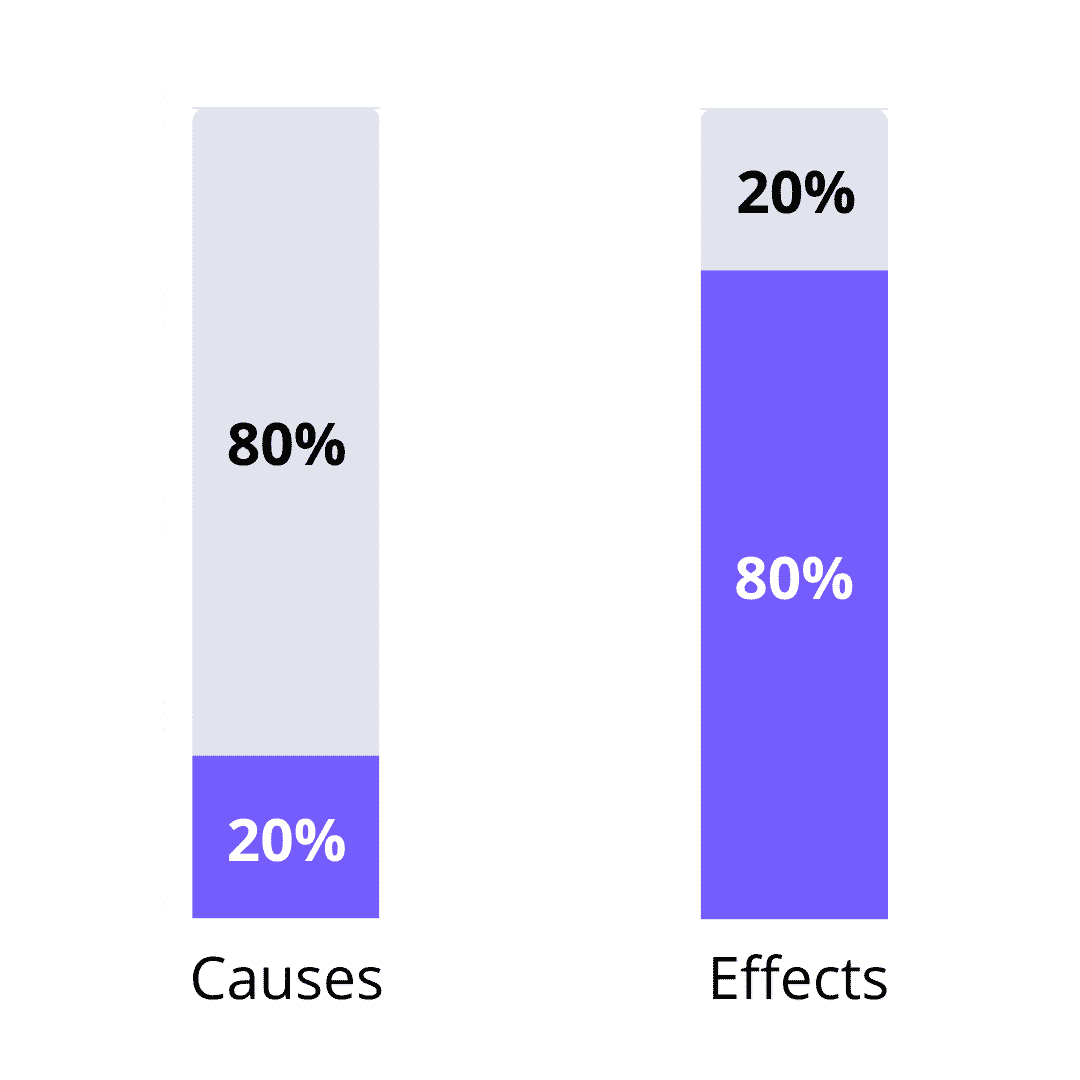
Optimize Easily your Well-being with the 80/20 rule Approach
Photo by the DigitalTreeCompany
Originally Posted On: https://paretoanalysis.tools/optimized-well-being-with-80-20-rule/
Happiness, the feeling of positivity, really is the foundation of productivity.
Take control now of your well-being by applying the simple yet powerful 20/80 Rule to your life. This article shows how to optimise your well-being easily with the 80/20 rule – also called the Pareto Principle – in 3 simple steps. Read and hack your happiness now! In a hurry? Take the shortcut here.
INTRO
The 80/20 Rule or the Pareto Principle states that about 80% of the results are driven by 20% of the efforts. Numbers put aside; the Pareto Principle means that a relevant minority of actions lead to a majority of good outcomes. In short, the 80/20 principle highlights the appropriate tasks to focus on from a logical perspective.

MAXIMISE WELL-BEING AND SELF-ACCOMPLISHMENT WITH THE 80/20 RULE
The 80/20 Rule for happiness is all bout taking control of your life with optimal project prioritisation and the execution of the right actions.
Suppose you are stuck in your daily routine with your nose close to the grindstone as you work hard to achieve personal and professional goals. In that case, you may end up feeling overwhelmed, unfulfilled and maybe depressed! If you are in that situation or simply if you identify yourself in the list below, it is time work smarter, not harder!
- I’m running in circles.
- I’m on a spinning wheel.
- I do not see any results.
- I don’t know where to start.
- I’m not getting anything done.
- I’m tired of doing this tedious task.
- I don’t know where it’s going to stop.
- I have a limited amount of time, but so much to do.
- I would rather be doing something more manageable.
Set some priorities to maximise your wellness with a 80/20 Rule approach. Instead of juggling with multiple activities but achieving nothing and feeling empty, pour your efforts and energy into the most meaningful activities, those that will maximise your well-being. This fact-based approach to life to maximise your wellness is what the 80/20 Rule or Pareto Principle approach for happiness is all about.
THE 80/20 RULE OR PARETO PRINCIPLE APPROACH FOR HAPPINESS
To optimise your well-being with a 80/20 Rule approach, simply follow the 3-step process below:
1) List your real-life examples where you can identify a 80/20 pattern
2) Classify these real-life examples into the following categories: NEGATIVE / NEUTRAL / POSITIVE
3) Take actions based upon the prior classification
1) LIST YOUR REAL-LIFE EXAMPLES WHERE YOU CAN IDENTIFY A 80/20 PATTERN
Of course, it doesn’t need to be an exact 80/20 split, but you get the idea  Here are a few real-life examples of the 80/20 Rule from a well-being perspective, assuming that you also consider financial aspects in your wellness assessment:
Here are a few real-life examples of the 80/20 Rule from a well-being perspective, assuming that you also consider financial aspects in your wellness assessment:
- only 20% of your social interactions may lead to 80% of the overall satisfaction you gain from socialising
- 20% of your activities may impact negatively 80% of your stress level
- 80% of your income may come from 20% of your income-generating activities
- 80% of your non-necessary expenses are due to 20% of your leisure activities
A quick aside regarding the financial aspects in your wellness assessment.
“It doesn’t matter how much money you make; it’s where you feel happy.”
While this well-being quote may suggest that in life, everything should be about happiness, others may think that money is still essential in the world we live in. After all, most of us still have to pay for our bills and basic needs such as food and accommodation. Such materials aspects may contribute to your well-being. More likely, money might be still essential to cover your basic needs in your situation. If so, please include them in your overall well-being assessment to find an optimal tradeoff.
2) CLASSIFY THESE REAL-LIFE EXAMPLES INTO THE FOLLOWING CATEGORIES: NEGATIVE / NEUTRAL / POSITIVE
- Negative → Things that put your mood down or stress you out!
- Neutral → Things that are somehow neutral, but that you cannot avoid in your current situation
- Positive → Things that make you feel good!
3) TAKE ACTIONS BASED UPON THE PRIOR CLASSIFICATION
- Negative → Stop doing: do not do or delegate
- Neutral → Keep going but establish and execute a plan to do less of this over time
- Positive → Keep going and enjoy! Do more if possible
80/20 RULE / PARETO PRINCIPLE TEMPLATE FOR WELL-BEING
NEGATIVE
⇒ Stop doing: do not do or delegate
- 80% of the time spent into the house chores accounts only for 20%of my to-do-list: I hate ironing!
- 20% of my clients are responsible for 80% of the problems: they stress me out as they are never satisfied with my deliveries. They always ask for more, and I tend to overwork because of them.
- 80% of my frustrations arise from my social media usage: I get jealous of some of my friends who seem to be more successful than me.
NEUTRAL
⇒ Keep going but establish and execute a plan to do less of this overtime
- 80% of my income comes from 2 loyal customers who account only for 20% of my client base: they pay very well, but they are not always easy to work with! Unfortunately, I still need their money; I have a mortgage!
POSITIVE
⇒ Keep going and enjoy! Do more if possible!
- 20% of my social interactions lead to 80% of my overall satisfaction. I’ve noticed that the social interactions I enjoy the most are those done in small groups or on a one-to-one basis. I should do less « group » activities!
- 80% of the activities I enjoy require no budget or a limited one. I love simple outdoor things such as walking by the beach or having a nice latte at my favourite cafés around the corner.
You can download the free 80/20 Rule / Pareto Principle for well-being template here:
LAST TIPS REGADING THE PARETO ANALYSIS FOR HAPPINESS
This Pareto Analysis for happiness is NOT meant to stay static! Things evolve over time. Redo it regularly, and adjust your priorities accordingly.
This Pareto Principle approach for well-being was inspired by the author Tim Ferriss. He wrote about it in all three of his books: The 4-Hour Work Week, The 4-Hour Body, and The 4-Hour Chef. The template is an adaptation of the 80/20 concept he presented in The 4-Hour Work Week. Tim Ferris might have a different approach on how to optimise well-being with the Pareto Principle. In this article, we offer our personal view  Please note that the links above are affiliate links: we may earn a small commission on any purchase made on Amazon.
Please note that the links above are affiliate links: we may earn a small commission on any purchase made on Amazon.
CONCLUSION AND SUGGESTIONS
If you want to learn more details about the 80/20 Principle, we invite you to visit the Frequently Asked Question section of the paretoanalysis.tools website. Alternatively, for 80/20 Principle Excel tutorials and other healthy productivity habits, we invite you to visit our blog.
